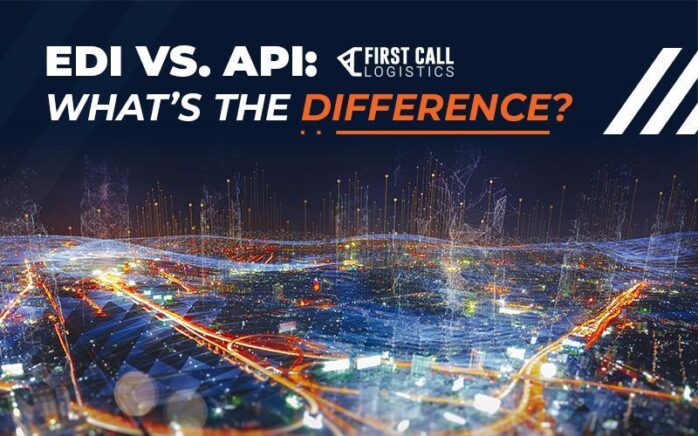Understanding EDI and API Freight Technology

The world of logistics would grind to a halt without efficient communication. However, the constant stream of data needed to keep the shipping industry’s moving parts running on time is too vast for your average company Slack channel. Instead, there are two basic systems logisticians use to automate data management — EDI and API.
These systems are designed to securely exchange bits of data automatically and serve as a building block of any modern business looking to fill and ship orders of increasing volumes at a more rapid pace. Your unique business priorities are the best basis for choosing between EDI and API systems.
How Does EDI Work?
In its simplest form, Electronic Data Interchange does just what its name indicates: allows companies to do business electronically by trading digital information. By standardizing the inputs and outputs of massive amounts of digital information, an EDI optimizes many of the traditional bookkeeping aspects of business management and minimizes the chances of human error when recording or transferring this data elsewhere.
EDI remains a go-to automated system for invoicing, order processing, and other fundamental operations for many businesses. It’s also been around for a while — the process of electronically standardizing and transmitting data from business documents dates back more than 50 years.
EDI Pros:
- EDI is easy to use and only takes a one-time setup process.
- It is considered extremely secure.
- EDI is familiar. Thanks to its lengthy track record, it is treated as industry-standard among most partners.
- It reduces cases of human error, which means higher data accuracy and lower overall operating costs.
EDI Cons:
- EDI can be expensive and time-consuming for a business to incorporate into its daily processes.
- Different versions of EDI exist, and they don’t always play well with one another. Business partners need to ensure they’re all working with the same tool for it to work properly.
- EDI is an old school technology, and fast-advancing modern tech may one day render it obsolete.
- Transmitting vast amounts of data takes time (even up to a few hours).
Understanding How EDI Works in the Shipping Industry
As you might have guessed, Application Programming Interface is the relatively new challenger to EDI’s long-held dominance in electronic systems. An API system is cloud-based, which means tons of information can be shared between multiple parties instantaneously. Real-time access is a big deal for big companies managing complex supply chains and high-volume orders. Where EDI limits the human element in data processing, an API eliminates it entirely.
API Pros:
- An API’s major selling point is its real-time data visibility for any party with the requisite access. Transmitting data via API is fast.
- APIs are easy to use and play nice with other systems, no matter which version they may use.
- They are built to support new tech as it develops (including blockchain technology).
API Cons:
- Not everyone currently using an EDI will want to make the switch to a whole new system
- As mentioned above, APIs are web-based, which is great for sharing lots of data instantly with multiple parties but potentially catastrophic if the wrong party gets ahold of it. Any data offering online access risks a security breach to some degree.
- An API lives and dies by its connection to the internet — if wifi is down, your business is as good as paused.
EDI and API Systems Are Critical to Today’s Shipping Industry
You’d be hard-pressed to find a corner of the logistics industry that doesn’t use one of these systems extensively every day. Automated data input, tracking, and communication have allowed drivers, shippers, and logistics providers to optimize their processes behind the scenes. This means real-time visibility for industry experts managing global supply chain issues and faster shipping for customers more accustomed to receiving products within 48 hours of placing an order.
How to Choose Between EDI and API
Your unique business priorities are the best basis for choosing between EDI and API systems. If lower up-front cost and compatibility with new technology and multiple partners is your key to success, API will fit the bill. If your current partners prefer the familiarity and security of a tried-and-true, EDI system, you’ll want to commit time to adapt that same system into your own process.
It’s also not entirely out of the question to adopt both, as a mix of API and EDI systems can provide the best of both worlds and allow for partners of all types to communicate data efficiently with your business.
Streamline Your Supply Chain Operations with First Call Logistics
Advancing technology is changing the supply chain industry with major innovations year over year. Whether you’re working with APIs or EDI integrations, we’ve got you covered. To learn how First Call can provide supply chain efficiencies to meet your business needs, contact us today.
Simplify your Next Shipment with First Call Logistics
More Resources for FCL Shippers:
- Article: Why Supply Chain Visibility Matters
- Article: Achieving Supply Chain Visibility with a TMS
- Article: Why You Need Supply Chain Traceability
- Article: Route Optimization: Cutting Costs & Improving Service
- Article: How to Identify Weak Points in Your Supply Chain
- Article: Safeguarding Your Business Against Logistics Fraud
- Article: 3 Keys to Disaster-Proofing Your Supply Chain
- Article: How to Identify Weak Points in Your Supply Chain
- Article: How Partnering With a 3PL Strengthens Your Supply Chain